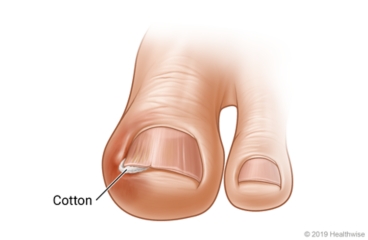Ingrown Toenail in Children: Care Instructions
Overview

An ingrown toenail is a toenail that has grown into the skin instead of over it. This usually happens to the
big toe, but it can also happen to other toes. It often occurs because a nail is not trimmed correctly or
because shoes are too tight.
Most ingrown toenails can be treated at home. But an ingrown nail can cause an infection. If your child's toe
is infected, the doctor may prescribe antibiotics.
Good nail care can help prevent ingrown toenails.
Follow-up care is a key part of your child's treatment and safety. Be sure to make and go to all
appointments, and call your doctor if your child is having problems. It's also a good idea to know your
child's test results and keep a list of the medicines your child takes.
How can you care for your child at home?
-
Trim the nails straight across. Leave the corners a little longer so they do not cut into the skin. To do
this when your child has an ingrown nail:
-
Soak the foot in warm water for about 15 minutes to soften the nail.
-
Wedge a small piece of wet cotton under the corner of the nail to cushion the nail and lift it
slightly. This keeps it from cutting the skin.
-
Repeat daily until the nail has grown out and can be trimmed.
-
Do not trim the toenails too short.
-
Have your child wear comfortable shoes that are roomy in the toe area.
-
Soak your child's foot in warm, soapy water for 10 to 20 minutes a few times each day.
-
If the doctor prescribed antibiotics, give them as directed. Do not stop using them just because your
child feels better. Your child needs to take the full course of antibiotics.
When should you call for help?
 Call your
doctor now or seek immediate medical care if:
Call your
doctor now or seek immediate medical care if:
Watch closely for changes in your child's health, and be sure to contact your doctor if:
Current as of: November 16, 2023
Content Version: 14.0
Care instructions adapted under license by your
healthcare professional. If you have questions about a medical condition or this instruction, always ask
your healthcare professional. Healthwise, Incorporated disclaims any warranty or liability for your use of
this information.